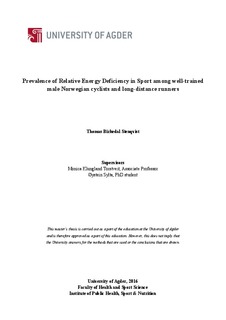| dc.description.abstract | Introduction
Relative Energy Deficiency in Sport (RED-S) links low and reduced energy availability (EA) with
negative health and performance consequences, though not well investigated in male endurance
athletes. The aim of this study was to investigate the prevalence of RED-S and associated health
consequences in well-trained male endurance athletes.
Methods
Forty-one subjects, cyclists (n=21) and runners (n=20) [age: 40 (31-45) years; BMI: 23.5 (21.4-24.0)
kg/m2; body-fat: 14.0% (10.0-16.5%); training volume: 12 (9-16) h/week presented as median +
interquartile range] were recruited. Protocol included assessment of bone health, body composition,
resting metabolic rate (RMR), blood pressure, energy intake, energy expenditure, hormonal
biomarkers, blood glucose and lipids. 27 subjects were included in the final analysis.
Results
Eighteen subjects had reduced EA (<40kcal/kgFFM/day) and showed a trend of lower RMR ratio
compared to the optimal EA group (0.83 vs. 0.86, P=0.026). Six subjects had low bone mineral
density (BMD), but not related to EA status. The reduced EA group showed a trend of higher BMD
in femur (P=0.037), hip (P=0.057), lumbar spine (P=0.01) and total body (P=0.035). No associations
between groups were observed in hormonal biomarkers, blood glucose or blood lipids.
Conclusion
We found high prevalence of reduced EA accompanied by metabolic alterations in this group of
well-trained athletes. However, no differences were observed between EA groups in either
anthropometric, hormonal biomarkers, blood glucose, blood lipids or BMD. This may indicate that
well-trained male endurance athletes are better protected against associations to negative health
consequences in combination with reduced EA, compared to female endurance athletes.
Keywords
Athlete health, bone health, energy availability, hormonal biomarkers, male endurance athletes,
resting metabolic rate
Due to word limitations in the master thesis, the following will only be present in the article (part 2);
results, discussion regarding results and conclusion | nb_NO |
